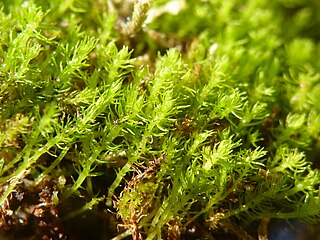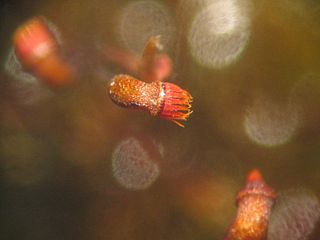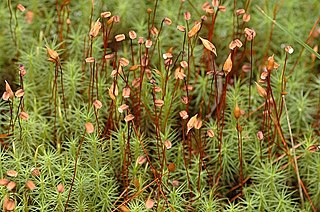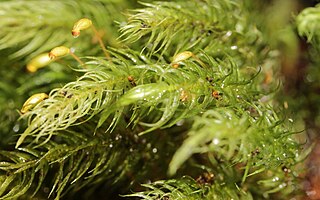| Aulacomniaceae | |
|---|---|
 | |
| Aulacomnium palustre | |
| Scientific classification | |
| Kingdom: | Plantae |
| Division: | Bryophyta |
| Class: | Bryopsida |
| Subclass: | Bryidae |
| Order: | Rhizogoniales |
| Family: | Aulacomniaceae Schimp. |
| Genera | |
See Classification | |
| Aulacomniaceae | |
|---|---|
 | |
| Aulacomnium palustre | |
| Scientific classification | |
| Kingdom: | Plantae |
| Division: | Bryophyta |
| Class: | Bryopsida |
| Subclass: | Bryidae |
| Order: | Rhizogoniales |
| Family: | Aulacomniaceae Schimp. |
| Genera | |
See Classification | |
Bell et al. (2007) describes members of the family:
The placement of the family has been subject to much revision. The family was first described by Wilhelm Philippe Schimper in his 1860 publication Synopsis Muscorum Europaeorum. [3] Bell et al. (2007) elevated the family to the order Aulacomniales. [2] However, the Goffinet et al. (2009) classification places the family within the Rhizogoniales. [1]
The genera represented by the order are:

Boraginaceae, the borage or forget-me-notfamily, includes about 2,000 species of shrubs, trees, and herbs in 146 to 156 genera with a worldwide distribution.

The Marchantiophyta are a division of non-vascular land plants commonly referred to as hepatics or liverworts. Like mosses and hornworts, they have a gametophyte-dominant life cycle, in which cells of the plant carry only a single set of genetic information.

Burmanniaceae is a family of flowering plants, consisting of 99 species of herbaceous plants in eight genera.

Takakia is a genus of two species of mosses known from western North America and central and eastern Asia. The genus is placed as a separate family, order and class among the mosses. It has had a history of uncertain placement, but the discovery of sporophytes clearly of the moss-type firmly supports placement with the mosses.

The Bryopsida constitute the largest class of mosses, containing 95% of all moss species. It consists of approximately 11,500 species, common throughout the whole world.

Polytrichaceae is a common family of mosses. Members of this family tend to be larger than other mosses with a thickened central stem and a rhizome. The leaves have a midrib that bears photosynthetic lamellae on the upper surface. Species in this group are dioicous. Another characteristic that identifies them is that they have from 32 to 64 peristome teeth in their sporangium.

The Funariidae are a widespread group of mosses in class Bryopsida. The majority of species belong to the genera Funaria and Physcomitrium.
Andreaeobryum, the Mossy Cowl Moss, is a genus of moss with a single species Andreaeobryum macrosporum, endemic to Alaska and western Canada. The genus is placed as a separate family, order and class among the mosses.

Bryales is an order of mosses.

Timmia is a genus of moss. It is the only genus in the family Timmiaceae and order Timmiales. The genus is named in honor of the 18th-century German botanist Joachim Christian Timm.

Fissidentaceae is a family of haplolepideous mosses (Dicranidae) in the order Dicranales, with a single genus, Fissidens. It was formerly placed in the now-obsolete order Fissidentales.

Hypnales is the botanical name of an order of Bryophyta or leafy mosses. This group is sometimes called feather mosses, referring to their freely branched stems. The order includes more than 40 families and more than 4,000 species, making them the largest order of mosses.

Leucobryaceae is a family of haplolepideous mosses (Dicranidae) in the order Dicranales.

Rhizogoniales is an order of mosses in the Bryopsida.

Splachnaceae is a family of mosses, containing around 70 species in 6 genera. Around half of those species are entomophilous, using insects to disperse their spores, a characteristic found in no other seedless land plants.

Hedwigiales is an order of mosses. It is named after Johannes Hedwig (1730-1799), the founder of modern bryology.

Mniaceae is a moss family in the order Bryales.

Orthodontiaceae is a family of mosses.
Calymperaceae is a family of haplolepideous mosses (Dicranidae) in the order Dicranales.
Helodium is a genus of mosses belonging to the family Helodiaceae.